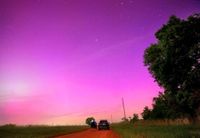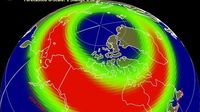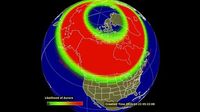The Northern Lights may be visible in the United States this weekend as a powerful geomagnetic storm is set to unfold, bringing potential awe-inspiring displays of aurora borealis. The National Oceanic and Atmospheric Administration (NOAA) indicated that a G3-class geomagnetic storm is projected to strike on Sunday, March 23, 2025. In an extraordinary event, the natural light show could stretch across as many as 21 U.S. states, enticing sky gazers to look for vibrant colors as far south as Nebraska and Indiana.
Detailed forecasts suggest that this weekend's space weather will be particularly dynamic. NOAA anticipates a strong G3 storm on Sunday, complemented by a minor G1 storm on Monday, March 24, and a moderate G2 storm on Tuesday, March 25. "A fast CME that left the sun on March 21 is expected to arrive at Earth by early on March 23," reported NOAA. This coronal mass ejection (CME), a dense cloud of charged particles, is expected to interact with Earth's magnetic field, producing potentially bright and active auroras.
Astounding displays of the Northern Lights can generally be observed as far south as Chicago in Illinois and Portland in Oregon during a storm of this nature. With the predicted intensity pegged at Kp 7, stargazers are encouraged to look north toward the horizon, where the auroras may form bands of color dancing across the night sky.
The states that could catch this spectacular sight include Washington, Oregon, Idaho, Montana, Wyoming, North Dakota, South Dakota, Nebraska, Minnesota, Iowa, Wisconsin, Illinois, Indiana, Michigan, Ohio, Pennsylvania, New York, Massachusetts, New Hampshire, Vermont, and Maine. The best chances for sightings lie in northern locations, with areas close to the Canadian border receiving the most direct influence from the storm.
Those wishing to witness the aurora should keep in mind several essential factors in order to maximize their experience. Optimal viewing conditions include clear, dark skies, far from the bright lights of major cities. According to forecasts, the best window to view the aurora will be between 10 PM and 2 AM local time on the night of March 22-23. NOAA experts note that a last quarter moon on March 22 will mean less moonlight interference, making it easier to see the auroras, provided weather conditions cooperate.
The science behind auroras can be quite fascinating. They occur when charged particles from the sun collide with Earth’s atmosphere, creating vibrant displays of light. During significant solar events associated with CMEs, these particles, primarily electrons and protons, become funneled toward the magnetic poles. As they collide with gases in the atmosphere, such as nitrogen and oxygen, these interactions release energy and produce the colorful show of lights.
This weekend's geomagnetic storm is particularly noteworthy due to the Russell-McPherron effect—a phenomenon that occurs around the equinox, which reportedly boosts the likelihood of auroras. "The Russell-McPherron effect boosts the effectiveness of CMEs around the equinox," noted a report from Spaceweather.com. This effect arises when the magnetic fields of the Earth and the solar wind align, creating conditions that allow the solar particles to penetrate the atmosphere more readily and produce stronger geomagnetic storms than usual.
Observers eager to view the Northern Lights should also heed advice on where to look. Tim Brothers, an instructor from the Massachusetts Institute of Technology, suggests heading toward local parks or conservation areas that minimize nighttime lighting, or perhaps a coastal area away from urban light pollution for an optimal experience. "We typically suggest getting away from cities and finding an open field or hilltop to lay out under the stars and wait for the show to really peak at the late evening or early morning hours," Brothers explained in a previous interview.
Overall, this weekend offers a thrilling opportunity for skywatchers across the country to witness a natural spectacle, driven by one of nature’s most beautiful processes. The anticipation of seeing such stunning displays is peppered with the reality that, while the forecasts are promising, auroras are inherently unpredictable. Whether they grace the sky or not, the energy of this celestial event serves as a reminder of the intricate relationship between our planet and the sun.
As the cosmic dance unfolds, viewers in the potential viewing areas should prepare carefully for this ephemeral wonder. The universe’s exhibition of light awaits, and it beckons adventure seekers and dreamers alike to look upward this weekend.




